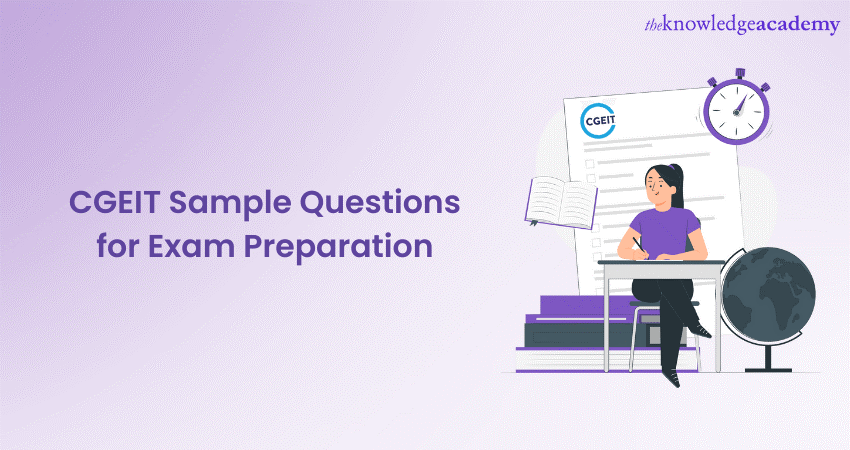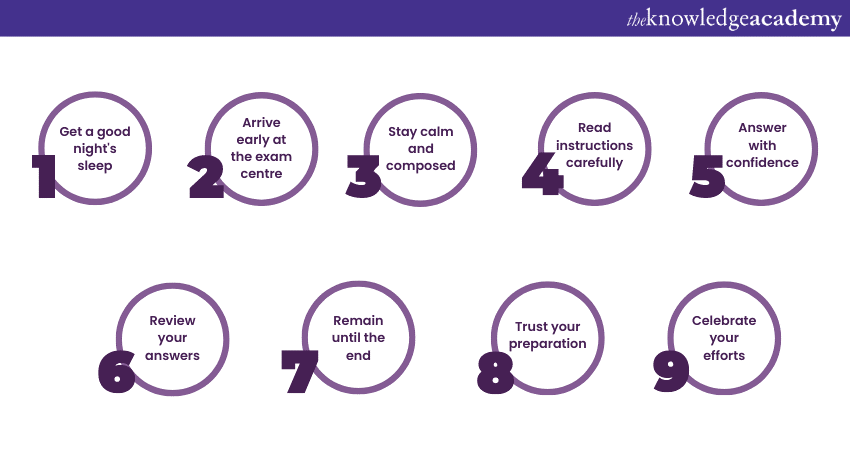We may not have the course you’re looking for. If you enquire or give us a call on +358 942454206 and speak to our training experts, we may still be able to help with your training requirements.
Training Outcomes Within Your Budget!
We ensure quality, budget-alignment, and timely delivery by our expert instructors.

IT governance plays a pivotal role in ensuring organisations' success and security nowadays. The Certified in the Governance of Enterprise IT (CGEIT) certification is a prestigious credential that validates professionals' expertise in IT governance. Obtaining this certification is hard as the exam is a tough nut to crack. By understanding the CGEIT Sample Questions provided in this blog, you can pass this exam with flying colours.
According to Talent.com, the average salary of an IT Governance Manager in the UK is about £60,000 per year. Having a CGEIT Certification increases your career prospects in this domain. In this blog, you will learn about the CGEIT Sample Questions with answers, along with some tips for the exam day. Let’s delve in deeper to learn more about it!
Table of Contents
1) CGEIT Sample Questions with answers
2) Tips to follow during the CGEIT exam
3) Conclusion
CGEIT Sample Questions and Answers
Preparing for the Certified in the Governance of Enterprise IT (CGEIT) exam requires a thorough understanding of the question formats and content. Exploring CGEIT sample questions is a valuable approach to familiarise yourself with the exam's structure and assess your knowledge in various domains. Let's explore some CGEIT Sample Questions for your exam preparation journey:
Question 1: Which of the following frameworks is commonly used for IT governance and aligning IT with business objectives?
A) Information Technology Infrastructure Library (ITIL)
B) Control Objectives for Information and Related Technologies (COBIT)
C) Information Security Management System (ISO/IEC 27001)
D) Project Management Body of Knowledge (PMBOK)
Answer 1:
B) COBIT Control Objectives for Information and Related Technologies ()
Explanation: COBIT is a widely recognised framework used for IT governance and aligning IT processes with business objectives. It offers a comprehensive set of controls and best practices to ensure effective management and governance of enterprise IT.

Question 2: In the IT governance context, what does "RACI" stand for?
A) Responsible, Accountable, Consulted, Informed
B) Risk Assessment and Control Implementation
C) Role, Authority, Control, Influence
D) Return on Investment, Assets, Capital, Income
Answer 2:
A) Responsible, Accountable, Consulted, Informed
Explanation: RACI is an acronym representing the roles and responsibilities of individuals involved in a particular process. It stands for Responsible (those responsible for completing the task), Accountable (the ultimate decision-makers), Consulted (those whose input is sought), and Informed (those kept informed of progress).
Question 3: Which domain of CGEIT focuses on aligning IT strategies with business objectives and ensuring IT's contribution to the organisation's success?
A) Framework for the Governance of Enterprise IT
B) Strategic management
C) Benefits realisation
D) Risk optimisation
Answer 3:
B) Strategic management
Explanation: The Strategic Management domain in CGEIT focuses on aligning IT strategies with overall business objectives, ensuring IT initiatives support the organisation's success, and identifying opportunities for IT to contribute strategically.
Question 4: Which of the following is a fundamental component of IT governance that provides the basis for decision-making and control?
A) Risk assessment
B) IT policies
C) Performance metrics
D) IT Infrastructure
Answer 4:
B) IT policies
Explanation: IT policies are fundamental components of IT governance. They provide the basis for decision-making and control, guiding IT activities and ensuring alignment with business objectives and regulatory requirements.
Question 5: What is the primary purpose of conducting a Post-Implementation Review (PIR) for IT projects?
A) In order to evaluate project risks and identify potential issues
B) In order to assess the project's overall performance and outcomes
C) In order to determine project resource utilisation and budget adherence
D)In order to review the project's timeline and milestones
Answer 5:
B) In order to assess the project's overall performance and outcomes
Explanation: The primary purpose of conducting a Post-Implementation Review (PIR) is to assess the project's overall performance, outcomes, and whether it achieved the intended objectives. It helps identify successes and areas for improvement in future projects.
These sample questions provide a glimpse of the types of questions you may encounter in the CGEIT exam. Regularly practising such questions will enhance your understanding of the exam's content and format, ensuring you are well-prepared to excel in the CGEIT exam and achieve your career goals in IT governance and strategic planning.
Tips to follow during the CGEIT exam
The day of the Certified in the Governance of Enterprise IT (CGEIT) exam can be both exciting and nerve-wracking. To help you perform at your best and approach the exam with confidence, here are some valuable test day tips to keep in mind:

1) Get a good night's sleep: Ensure you get enough rest the night before the exam. A well-rested mind is more alert and better equipped to handle complex questions during the test.
2) Arrive early at the exam centre: Plan to arrive at the exam centre early to avoid unnecessary stress. This allows you time to complete any required registration and familiarise yourself with the surroundings.
3) Stay calm and composed: Keep a calm and positive mindset throughout the exam. If you encounter challenging questions, take a deep breath and focus on answering to the best of your abilities.
4) Read instructions carefully: Before diving into the questions, carefully read the exam instructions. Understand the rules and time limits for each section to manage your time effectively.
5) Answer with confidence: Answer questions confidently based on your knowledge and preparation. Avoid second-guessing too much, as it can lead to unnecessary confusion.
6) Review your answers: If time allows, review your answers before submitting the exam. Check for any overlooked mistakes or opportunities to provide a more accurate response.
7) Remain until the end: Once you have completed the exam and reviewed your answers, avoid leaving early. Use any remaining time to recheck your responses and ensure you haven't missed anything.
8) Trust your preparation: Remember that you've put in considerable effort to prepare for the CGEIT exam. Trust your preparation and believe in your abilities to excel.
9) Celebrate your efforts: After the exam, take a moment to celebrate your efforts and the progress you've made in your career journey.
By following these tips during the test, you can approach the CGEIT exam with confidence, stay focused, and showcase your knowledge and skills effectively. Obtaining this qualification will increase your chances in CGEIT Jobs. Best of luck in achieving your CGEIT certification and advancing your career in IT governance and strategic planning!
Elevate your skills in governance with our CGEIT Training (Certified In The Governance Of Enterprise IT). Sign up today!
Conclusion
We hope you read and understand CGEIT Sample Questions. The CGEIT exam presents a significant opportunity for professionals to advance their careers in IT governance. By following effective test day strategies and trusting their preparation, you can confidently approach the exam and achieve success.
Prepare to earn the prestigious certification and advance your career with our CGEIT Training Courses. Sign up now!
Frequently Asked Questions
Upcoming IT Security & Data Protection Resources Batches & Dates
Date
 CGEIT training (Certified in the Governance of Enterprise IT)
CGEIT training (Certified in the Governance of Enterprise IT)
Thu 13th Mar 2025
Thu 5th Jun 2025
Thu 11th Sep 2025
Thu 6th Nov 2025







 Top Rated Course
Top Rated Course


 If you wish to make any changes to your course, please
If you wish to make any changes to your course, please


